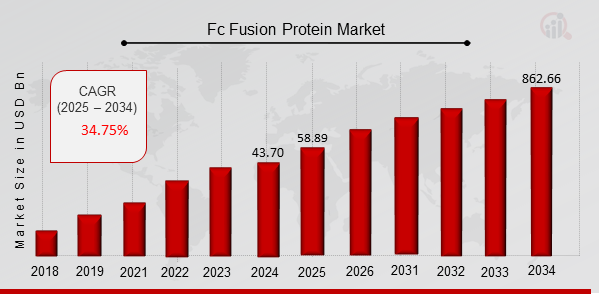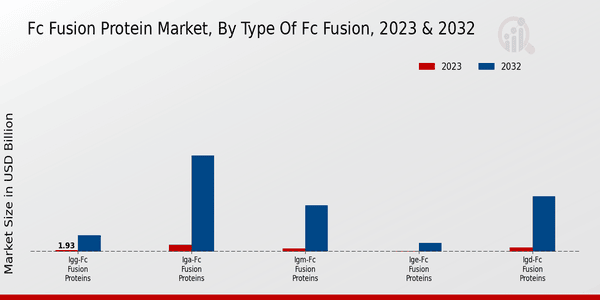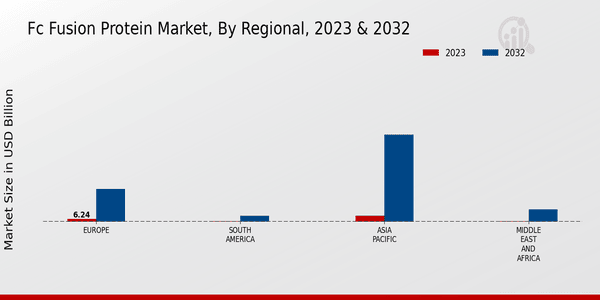Fc Fusion Protein Market Overview
As per MRFR analysis, the Fc Fusion Protein Market Size was estimated at 43.70 (USD Billion) in 2024. The Fc Fusion Protein Market Industry is expected to grow from 58.89 (USD Billion) in 2025 to 862.66 (USD Billion) till 2034, at a CAGR (growth rate) is expected to be around 34.75% during the forecast period (2025 - 2034).
Key Fc Fusion Protein Market Trends Highlighted
It is expected that the Fc fusion protein market will gain remarkable growth within the forecast period, aided by some factors in the marketplace. These factors include increasing cases of chronic diseases, an increasing market for biologics, and advances in biotechnology solutions. In addition, the growing concern over precision healthcare, as well as rising expenditure on research and development, widens the market scope. The FC fusion protein market is promising since new therapeutic uses come up. The use of Fc fusion proteins in combination with other approaches, such as targeted drug delivery systems and immunotherapy, offers great promise. Furthermore, the rise of biosimilars and penetrating new markets are more opportunities for players in the industry. Also, recent patterns in the Fc fusion protein market trends are the growing use of subcutaneous routes of administration, long-acting formulations, and more emphasis on the patient’s needs during drug design. Market leaders are seeking strategic collaborations, acquisitions, and licensing deals to fortify their portfolios and increase their market penetration.

Source Primary Research, Secondary Research, MRFR Database and Analyst Review
Fc Fusion Protein Market Drivers
Rising Prevalence of Chronic Diseases
The prevalence of several chronic diseases, including cancer, autoimmune disorders, and inflammatory diseases, is increasing significantly, thus stimulating the growth of the worldwide Fc fusion protein market. These medical conditions require the employment of Fc fusion proteins due to their high efficacy in targeting particular immune pathways and modulating the immune response. For example, rituximab, an Fc fusion protein, is employed to treat non-Hodgkin lymphoma and chronic lymphocytic leukemia.Therefore, the increasing prevalence of chronic diseases will be noted in the future decades and will drive the demand for Fc fusion proteins.
Technological Advancements and Innovation
Technological advancements and innovation have been crucial to the growth of the Fc Fusion Protein Market Industry. Thanks to technology, new and more powerful Fc fusion proteins can be developed. Genetic engineering and protein engineering are used, both of which are only possible today because of technology. Another technological advancement that has helped the growth of the industry is improvements to the manufacturing process, which have greatly reduced the cost of production, thus making Fc fusion proteins more accessible to patients.Finally, today, research and development efforts focus on creating novel Fc fusion proteins that are even more effective and have even fewer side effects.
Government Support and Regulatory Approvals
The growth of the Fc Fusion Protein Market Industry is dependent on government support and regulatory approvals. Policies are being passed by governments worldwide, and adequate funds are allocated to facilitate the research and development process of Fc Fusion Proteins. There has been a positive move within the regulatory authorities worldwide, setting a streamlined process for the approval of Fc Fusion Proteins, hence reducing the time and cost associated with the process.The regulation environment has been encouraging, thereby boosting market growth since pharmaceutical companies have significantly geared their investment in the development and commercialization of Fc Fusion Proteins.
Fc Fusion Protein Market Segment Insights
Fc Fusion Protein Market Type of Fc Fusion Insights
The Fc Fusion Protein Market is divided based on the kind of Fc fusion into IgG-Fc fusion proteins, IgA-Fc fusion proteins, IgM-Fc fusion proteins, IgE-Fc fusion proteins, and IgD-Fc fusion proteins. Of these, the IgG-Fc fusion proteins section is projected to be the biggest shareholder in the market. Such proteins are highly stable and have a long half-life sweet of use in drugs. They are also simple to produce and purify, which is another advantage in terms of the cost. The IgA-Fc fusion proteins section is also anticipated to advance at a robust pace, which will be due to the ability to induce mucosal immunity, which is essential in protecting against infections at mucosal surfaces.The IgM-Fc fusion proteins will similarly draw in more users because of their efficacy in treating autoimmune illnesses and cancer. The Fc Fusion Protein Market is likely to see substantial growth in the upcoming years due to the rising prevalence of chronic diseases, the increase in the demand for biologics, and the steady advancement of the genetic engineering sector. North America will likely be the regional leader, followed by Europe and Asia-Pacific. In addition, this market will establish itself as highly profitable and integral to the field of medicine, harvesting more customers every year.

Source Primary Research, Secondary Research, MRFR Database and Analyst Review
Fc Fusion Protein Market Target Disease Insights
Target Disease Segment Oncology, Immunology, Neurology, Infectious Diseases, and Cardiovascular Diseases are the prime target disease areas for Fc Fusion Proteins. Oncology is the dominant market, with a revenue share of over 50% by 2023 in the Fc Fusion Protein Market. The increasing incidence of cancer and the development of targeted therapies drive the growth of this segment. Immunology is the second-largest segment concentrating on autoimmune diseases and immune-mediated disorders. Neurology is emerging with the growing prevalence of neurodegenerative diseases.Infectious Diseases and Cardiovascular Diseases are also delivering lucrative growth of Fc Fusion Proteins by addressing unmet medical needs and providing innovative treatment options.
Fc Fusion Protein Market Molecular Weight Insights
The Fc Fusion Protein Market segmentation by Molecular Weight offers insights into the market's diverse range of products. In 2023, the 'Less than 100 kDa' segment held the largest revenue share of around 45%, owing to the wide application of these fusion proteins in therapeutic areas such as oncology and immunology. The '100-250 kDa' segment is projected to witness a CAGR of approximately 36.5% during the forecast period, driven by the increasing adoption of fusion proteins in the development of novel biologics. The '250-500 kDa' and 'More than 500 kDa' segments are also anticipated to grow steadily, capturing a significant share of the Fc Fusion Protein Market revenue in the coming years.
Fc Fusion Protein Market Function Insights
Function Segment The Fc Fusion Protein Market is segmented by function into Antibody-based, Cytokine-based, Hormone-based, Enzyme-based, and Other. Antibody-based Fc fusion proteins are the largest segment, accounting for over 50% of the market in 2023. The growth of this segment is attributed to the increasing use of monoclonal antibodies in the treatment of various diseases, such as cancer and autoimmune disorders. Cytokine-based Fc fusion proteins are the second-largest segment, with a market share of over 20%. These proteins are used to treat a variety of inflammatory and immune-mediated diseases.Hormone-based Fc fusion proteins are used to treat endocrine disorders, such as growth hormone deficiency and diabetes. Enzyme-based Fc fusion proteins are used to treat a variety of metabolic disorders, such as Gaucher disease and Fabry disease. The Other segment includes Fc fusion proteins that are used for a variety of other applications, such as gene therapy and tissue engineering. The Fc Fusion Protein Market is expected to grow at a CAGR of over 30% during the forecast period 2023-2032. The growth of the market is attributed to the increasing prevalence of chronic diseases, the rising demand for biologics, and the technological advancements in the field of biotechnology.
Fc Fusion Protein Market Application Insights
The Fc Fusion Protein Market is segmented based on its application into therapeutic, diagnostic, and research applications. The therapeutic segment is expected to dominate the market due to the increasing prevalence of chronic diseases and the rising demand for targeted therapies. The diagnostic segment is also expected to witness significant growth due to the increasing adoption of Fc fusion proteins in various diagnostic assays. The research segment is expected to grow steadily due to the increasing use of Fc fusion proteins in preclinical research and drug discovery.For instance, in 2023, the therapeutic segment accounted for approximately 60% of the Fc Fusion Protein Market revenue. This dominance is attributed to the increasing use of Fc fusion proteins in the treatment of various chronic diseases such as cancer, autoimmune disorders, and inflammatory diseases. The diagnostic segment is also expected to witness significant growth over the forecast period due to the increasing adoption of Fc fusion proteins in various diagnostic assays. For example, Fc fusion proteins are being used in the development of immunoassays for the detection of biomarkers associated with various diseases.The research segment is expected to grow steadily due to the increasing use of Fc fusion proteins in preclinical research and drug discovery. For example, Fc fusion proteins are being used to study the mechanisms of action of various drugs and to identify new drug targets.
Fc Fusion Protein Market Regional Insights
The Fc Fusion Protein Market is segmented into North America, Europe, APAC, South America, and MEA. Among these regions, North America held the largest market share in 2023 and is expected to continue its dominance throughout the forecast period. The growth in this region can be attributed to the increasing prevalence of chronic diseases, the rising adoption of biologics, and the presence of major pharmaceutical companies. Europe is the second-largest market for Fc fusion proteins, driven by the high healthcare expenditure, the presence of a large patient population, and the increasing adoption of advanced therapies.APAC is expected to witness significant growth in the coming years due to the increasing healthcare awareness, the rising disposable income, and the growing prevalence of chronic diseases. South America and MEA are relatively smaller markets for Fc fusion proteins, but they are expected to show steady growth in the coming years as a result of the increasing healthcare infrastructure, the rising adoption of biologics, and the growing prevalence of chronic diseases.

Source Primary Research, Secondary Research, MRFR Database and Analyst Review
Fc Fusion Protein Market Key Players And Competitive Insights
Key players in the Fc Fusion Protein Market industry have continuously adopted strategic initiatives that keep them competitive. The players in this market have widely focused on the innovation of products, product variety increase, and forging of partnerships that make them advance in the market space. As such, the market space of Fc Fusion Protein exhibits competition characteristics with players being interested in the market share. Some of the players have opted to embrace technology advancements for product innovations. Furthermore, most of these players have an interest in the research and development sector. Below are some of the insights on the competitive nature of the Fc Fusion Protein Market and players thereof. The article has also outlined some of the strategies adopted by Roche in the Fc Fusion Protein Market as well as insights taken from Pfizer.RocheRoche is by far a leading player in this market. The company is popular with its substantial pipeline and robust product portfolio. The company has had favorable outcomes in clinical settings with its Fc fusion protein-based medications. Of note is also the company’s critical investment in technologies, which has made their pipeline potential better. Consequently, this has made the company competitive in this market. From the insights, it is up to say that Roche’s focused innovation agenda and emphasis on patient-centeredness have retained its competitive nature in the Fc Fusion Protein Market.PfizerIn the context of the Fc Fusion Protein Market, Pfizer has always been a key competitor. The company has wide product portfolios and has put in place major alliances and partnerships that have helped it expand its global market share. Besides, Pfizer’s products also have a positive clinical setting history and exhibit high potential in its various therapeutic uses all over the world. The company has also adopted strategic partnerships with leading research organizations. Pfizer has also used its commercial potential to enter new markets and, hence, increase market share.
Key Companies in the Fc Fusion Protein Market Include
- Gilead Sciences
- AbbVie Biopharmaceuticals
- Amgen
- Bristol Myers Squibb
- Roche
- Takeda Pharmaceuticals
- AstraZenec a
- Merck KGaA
- Celgene Corporation
- Pfizer
- Eli Lilly
- Novartis
- SanofiAventis
- Johnson Johnson
Fc Fusion Protein Market Industry Developments
The Fc Fusion Protein Market is anticipated to exhibit substantial growth in the coming years, driven by the increasing prevalence of chronic diseases, rising adoption of biologics, and technological advancements. In 2023, the market was valued at approximately USD 24.07 billion, and it is projected to reach USD 352.5 billion by 2032, expanding at a CAGR of 34.75%. Key market players include Roche, AbbVie, Amgen, and Pfizer. Recent developments in the market include the approval of new Fc fusion protein therapies, such as Hemlibra and Cablivi, and ongoing clinical trials evaluating the efficacy and safety of novel Fc fusion protein candidates.
Fc Fusion Protein Market Segmentation Insights
- Fc Fusion Protein Market Type of Fc Fusion Outlook
- IgG-Fc Fusion Proteins
- IgA-Fc Fusion Proteins
- IgM-Fc Fusion Proteins
- IgE-Fc Fusion Proteins
- IgD-Fc Fusion Proteins
- Fc Fusion Protein Market Target Disease Outlook
- Oncology
- Immunology
- Neurology
- Infectious Diseases
- Cardiovascular Diseases
- Fc Fusion Protein Market Molecular Weight Outlook
- Less than 100 kDa
- 100-250 kDa
- 250-500 kDa
- More than 500 kDa
- Fc Fusion Protein Market Function Outlook
- Antibody-based
- Cytokine-based
- Hormone-based
- Enzyme-based
- Other
- Fc Fusion Protein Market Application Outlook
- Therapeutic
- Diagnostic
- Research
- Fc Fusion Protein Market Regional Outlook
- North America
- Europe
- South America
- Asia Pacific
- Middle East and Africa
| Report Attribute/Metric |
Details |
|
Market Size 2024
|
43.70 (USD Billion)
|
|
Market Size 2025
|
58.89 (USD Billion)
|
|
Market Size 2034
|
862.66 (USD Billion)
|
|
Compound Annual Growth Rate (CAGR)
|
34.75 % (2025 - 2034)
|
|
Report Coverage
|
Revenue Forecast, Competitive Landscape, Growth Factors, and Trends
|
|
Base Year
|
2024
|
|
Market Forecast Period
|
2025 - 2034
|
|
Historical Data
|
2020 - 2024
|
| Market Forecast Units |
USD Billion |
| Key Companies Profiled |
Gilead Sciences, AbbVie Biopharmaceuticals, Amgen, Bristol Myers Squibb, Roche, Takeda Pharmaceuticals, AstraZenec a, Merck KGaA, Celgene Corporation, Pfizer, Eli Lilly, Novartis, SanofiAventis, Johnson Johnson |
| Segments Covered |
Type of Fc Fusion, Target Disease, Molecular Weight, Function, Application, Regional |
| Key Market Opportunities |
Cancer Immunotherapy Advancements Biosimilar Development Increasing Prevalence of Autoimmune Diseases Gene and Cell Therapy Integration Precision Medicine and Drug Development |
| Key Market Dynamics |
Rising prevalence of chronic diseases technological advancements increasing RampD expanding applications in oncology and growing adoption in emerging markets |
| Countries Covered |
North America, Europe, APAC, South America, MEA |
Frequently Asked Questions (FAQ) :
The Fc Fusion Protein Market size is estimated to be worth USD 43.70 billion in 2024 and is projected to grow to USD 862.66 billion by 2034, exhibiting a CAGR of 34.75% during the forecast period.
North America is expected to account for the largest market share in the Fc Fusion Protein Market, owing to the presence of major pharmaceutical companies and advanced healthcare infrastructure.
The growing prevalence of chronic diseases, technological advancements in protein engineering, and increasing demand for targeted therapies are key factors driving the growth of the Fc Fusion Protein Market.
The oncology segment is expected to account for the largest market share in the Fc Fusion Protein Market due to the increasing prevalence of cancer and the development of novel Fc Fusion Protein-based cancer therapies.
Key competitors in the Fc Fusion Protein Market include Roche, AbbVie, Amgen, Pfizer, and Bristol-Myers Squibb.
The Fc Fusion Protein Market is expected to grow at a CAGR of 34.75% from 2025 to 2034.

















